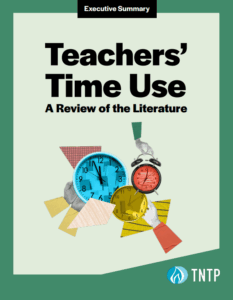This piece was first published in New York Daily News.
There aren’t many things in life you can count on, but here’s one: Whenever it’s time for the city to negotiate a new contract with the United Federation of Teachers, the union will sound the alarm about teachers fleeing to the suburbs because of low salaries.
So it came as no surprise when, earlier this month, amid news that the two sides have begun working on a deal, the UFT released a report warning of a “mass exodus” of teachers in recent years, especially to suburban schools, and suggesting that the only solution is a big, across-the-board raise.
But there’s a big hole in the union’s logic. It turns out that the vast majority of the city’s 75,000-plus teachers actually aren’t going to the suburbs—or anywhere else, for that matter.
In 2012, my organization studied teacher retention in New York and three other large urban districts, and found that the city actually keeps close to 90 percent of its teachers every year and over 90 percent of its senior teachers. The UFT’s own report found virtually no turnover among the most experienced teachers, and asserted that only 12 percent of teachers who leave before retirement end up teaching in the suburbs (allegedly because of better salaries and working conditions, although the union offered no data to support that theory).
More importantly, the UFT isn’t asking the crucial question about teacher retention: Are the teachers who are leaving the ones we want to keep?
It’s a tragedy when a great teacher leaves a school, but research tells us that same school would actually be better off when a consistently ineffective teacher leaves. When you are retaining 90 percent of your teachers, what matters isn’t just how many teachers are leaving, but which teachers are leaving. Focusing on the overall retention rate without regard to performance is a little like reviewing a book based on its word count, instead of whether you enjoyed reading it.
Viewed on these terms, the city really does appear to have a teacher retention problem. Our research found that the city loses almost half of its very best teachers—ones so good that they are nearly impossible to replace—within the first five years of their careers.
At the same time, it keeps nearly all of its least effective teachers, leading to a situation where thousands of teachers in the city with more than seven years of experience struggle to get the same results as the average rookie teacher.
The good news is that Mayor de Blasio has said he wants to make retaining the city’s top teachers a “personal crusade.” But to deliver on that commitment, he will need to push the UFT to accept some major changes in the new teachers’ contract.
Consider teacher salaries. The UFT’s priority is ensuring the same treatment—and the same raises—for all its members, as though one teacher is as good as any other. However, if the goal is keeping more great teachers in the city’s classrooms, giving the same raise to everyone isn’t the best use of scarce taxpayer dollars.
Instead, the city should provide especially large increases for the group that is leaving too soon: outstanding teachers who are in the first five years of their careers. These teachers have a proven track record of success in the classroom but are earning $60,000 a year or less. A substantial raise could convince them to stay longer than they might otherwise.
We’ve seen that happen in cities like Washington, where the best teachers can earn six-figure salaries early in their careers. We found that almost none of D.C.’s best teachers leave over dissatisfaction with their compensation, whereas low pay was one of the top three reasons why great teachers leave New York City.
The city could afford larger raises for outstanding early-career teachers by giving smaller raises to veteran teachers—who are already making $80,000 or even $100,000 a year, and who rarely leave before they reach retirement age regardless of their salary—and to early-career teachers who haven’t yet become stars. The city can then lay the groundwork for ensuring that high-performing veterans receive future increases that recognize their extraordinary talent and experience.
De Blasio will have to do some hard bargaining with the UFT to change the city’s one-size-fits-all teacher pay scale in the upcoming contract. But if he’s serious about helping schools hold on to more of their best teachers, he can’t let this opportunity pass him by.
Let’s hope he has the courage to do what it takes to solve the city’s real teacher retention crisis.








